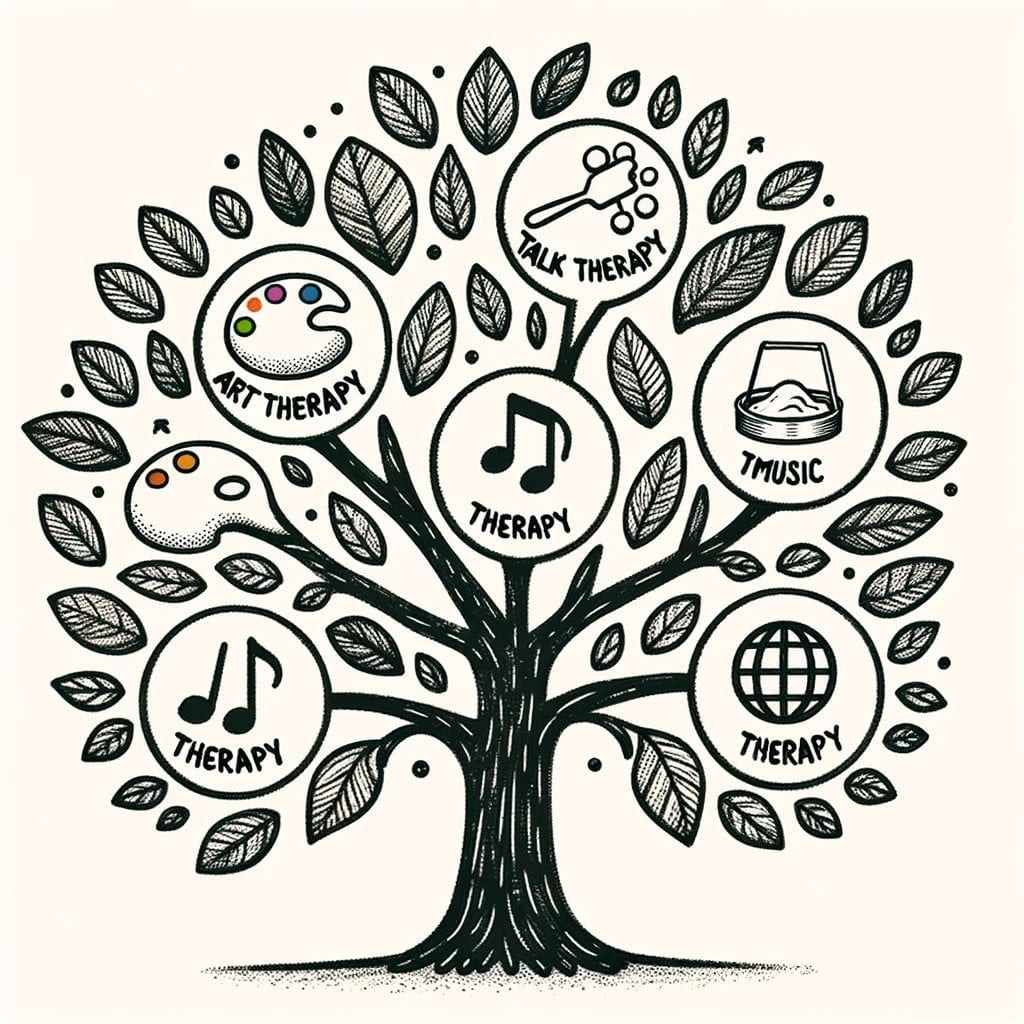Are you interested in learning more about the various forms of therapy that can assist people in navigating the complexities of life? There is no need to look further! This exhaustive guide aims to examine five potent therapeutic approaches that have the capacity to profoundly alter individuals’ lives. Understanding these diverse therapeutic techniques can serve as an initial step towards discovering alleviation and restoration, whether oneself or someone they are acquainted with is grappling with anxiety, depression, trauma, or relationship difficulties. Therefore, if you are prepared to commence a voyage of self-exploration and development, we should explore the realm of therapy together and unveil the profound potential that lies ahead.
5 Types of Therapy
Within the domain of mental health, therapy serves as an indispensable instrument in assisting people to surmount a multitude of obstacles and enhance their holistic state of being. There are numerous varieties of therapy, each with its own methodology and advantages. Cognitive-Behavioral Therapy (CBT), Psychodynamic Therapy, Humanistic Therapy, Psychoanalytic Therapy, and Integrative or Holistic Therapy are the five varieties of therapy that will be examined in this article.
CBT is cognitive-behavioral therapy.
Cognitive-behavioral therapy (CBT) is an exceptionally prevalent and efficacious therapeutic modality. It emphasizes the relationship between emotions, beliefs, and actions. CBT identifies and modifies maladaptive or erroneous thought patterns that are the primary cause of emotional distress. Through the substitution of these pessimistic thoughts with ones that are more precise and optimistic, people can observe enhancements in their emotional state and conduct.
Cognitive-behavioral therapy is predicated on the notion that our emotions and behaviors are influenced by the beliefs we hold. By challenging and modifying unhelpful beliefs, it empowers individuals to cultivate healthier emotions and behaviors. Anxiety disorders, melancholy, eating disorders, and addiction are frequently treated with CBT.
“Cognitive-behavioral therapy is like a compass that guides individuals towards positive thinking and healthier actions, helping them navigate through the challenges of life.”
Psychodynamic Treatment
Psychodynamic therapy is founded on the tenet that our current behaviors, emotions, and thoughts are influenced by our past experiences, specifically those that occurred during our infancy. The objective of this therapeutic approach is to reveal the latent conflicts and unresolved matters that are contributing factors to an individual’s present challenges. Through the recognition and comprehension of these latent issues, people can acquire a deeper comprehension of their emotions and actions, thereby creating an avenue for restoration and individual development.
An integral component of psychodynamic therapy is the exploration of an individual’s dreams, formative experiences, and relationships. It affords individuals a secure setting in which to delve into their emotions and acquire a more profound comprehension of their internal realm. A prevalent indication for the application of this therapeutic approach is in the treatment of trauma, relationship difficulties, and personality disorders.
“Psychodynamic therapy is like an archaeologist uncovering buried treasures from our past, enabling us to understand ourselves better and create a brighter future.”
Humanistic Treatment
The primary objective of humanistic therapy is to facilitate individual development and the achievement of self-actualization. It emphasizes the capacity for self-awareness, personal responsibility, and choice among individuals. The therapist establishes a nurturing and empathetic setting, which enables people to delve into their emotions, principles, and aspirations. Humanistic therapy empowers clients to effect positive life changes by encouraging them to actively participate in their own therapeutic voyage.
This therapeutic approach facilitates the growth of individuals’ self-awareness, self-confidence, and interpersonal connections. Particularly advantageous are those who are experiencing challenges related to self-acceptance, identity, and diminished self-esteem.
“Humanistic therapy is like a nurturing garden where individuals can blossom into their true selves, embracing their unique beauty and potential.”
The Psychoanalytic Method
The foundations of psychoanalytic therapy lie in the contributions of Sigmund Freud. Its primary objective is to comprehend the impact that the unconscious mind exerts on an individual’s emotions, thoughts, and actions. By engaging in dream analysis, free association, and interpretation, individuals are able to acquire a deeper understanding of their latent conflicts and aspirations. By consciously becoming cognizant of these subliminal processes, people have the ability to liberate themselves from their constraints and effectuate enduring transformations.
Typically, psychoanalytic therapy is an intensive, long-term treatment that explores the intricacies of the individual’s psyche. Unresolved trauma, personality disorders, and deep-seated emotional issues are among the many conditions for which it is prescribed.
“Psychoanalytic therapy is like unraveling the threads of our unconscious mind, allowing us to mend the fabric of our being and create a stronger, healthier self.”
Holistic or integrative therapy
Integrative or holistic therapy adopts a holistic perspective by integrating a multitude of therapeutic techniques and theories in accordance with the specific requirements of each individual. This approach to therapy acknowledges the uniqueness of each individual and the fact that no single treatment is universal. By combining components of various therapeutic modalities, integrative therapy generates an individualized and efficacious treatment strategy.
Integrative therapy encompasses a variety of approaches, including experiential therapy, cognitive restructuring, and mindfulness, to address multiple facets of an individual’s well-being. Complex problem-solvers or those who have exhibited unfavorable responses to conventional therapeutic approaches may find this approach especially beneficial.
“Integrative or holistic therapy is like a toolbox filled with different techniques, allowing therapists to create a customized solution that fits each individual’s needs perfectly.”
In summary, therapy provides a journey of healing and transformation for those in search of support and development. Each of the five therapies under discussion—integrative or holistic therapy, psychodynamic therapy, humanistic therapy, psychoanalytic therapy, and cognitive-behavioral therapy (CBT)—has its own distinct advantages and methods. Bear in mind that clinicians frequently incorporate strategies from various therapeutic modalities, customizing the intervention to target particular requirements. Analyzing these various forms of therapy can assist you in identifying the most compatible approach that promotes your overall well-being, whether you are grappling with anxiety, depression, trauma, or relationship concerns.
Physical therapy is a fundamental component in the process of recuperating from a wide range of ailments and injuries. Looking for information on the various varieties of physical therapy and their respective advantages? Your search is over. An exhaustive enumeration of five distinct types of physical therapy has been assembled with the intention of facilitating a speedier recovery and enhancing general health. Whether one is confronted with neurological disorders, musculoskeletal disorders, or sports injuries, our comprehensive guide will furnish invaluable guidance and information. So, why wait? Discover the power of physical therapy by clicking on the link below.
FAQ
Inquiry 1: What are psychodynamic therapy and psychoanalysis?
Answer: By identifying the unconscious meanings and motivations of problematic behaviors, emotions, and thoughts, psychodynamic and psychoanalytic therapies aim to alter them. By increasing an individual’s awareness of unresolved conflicts from infancy or previous experiences, these therapies facilitate the development of insight into one’s thoughts and emotions.
What is the mechanism of action of behavior therapy?
Behavior therapy places emphasis on the influence of learning on the formation of both typical and atypical behaviors. The objective is to recognize and alter maladaptive or undesirable behaviors through the application of methods including modeling, classical conditioning, and operant conditioning. This therapy assists individuals in comprehending the process by which their behaviors are acquired and offers techniques to substitute maladaptive behaviors with more beneficial alternatives.
Thirdly, define cognitive therapy.
Answer: The primary objective of cognitive therapy is to alter maladaptive thoughts, emotions, and behaviors through the identification of their unconscious motivations and significance. It emphasizes the influence of beliefs on behaviors and emotions. This therapeutic approach assists individuals in recognizing and questioning negative or irrational thoughts, thereby encouraging the development of more constructive thought patterns and enhancing their general state of being.
Fourthly, what precisely is humanistic therapy?
Humanistic therapy emphasizes the inherent capacity for self-actualization and development in the individual. The organization’s objective is to establish a therapeutic setting that is both encouraging and impartial, allowing people to examine their emotions and actions. This therapeutic approach places emphasis on individual accountability, self-reflection, and the endeavor to achieve personal objectives, with the ultimate aim of cultivating personal development and satisfaction.
Question 5: What is holistic or integrative therapy?
Integrative, or holistic, therapy is an approach that amalgamates components from multiple therapeutic modalities. This therapy acknowledges the fact that every person is distinct and that a singular approach might not be adequate. Through the incorporation of methodologies and tactics derived from various therapeutic frameworks, integrative or holistic therapy endeavors to furnish a thorough and individualized course of action in order to confront the intricate characteristics of human experiences and psychological concerns.



















